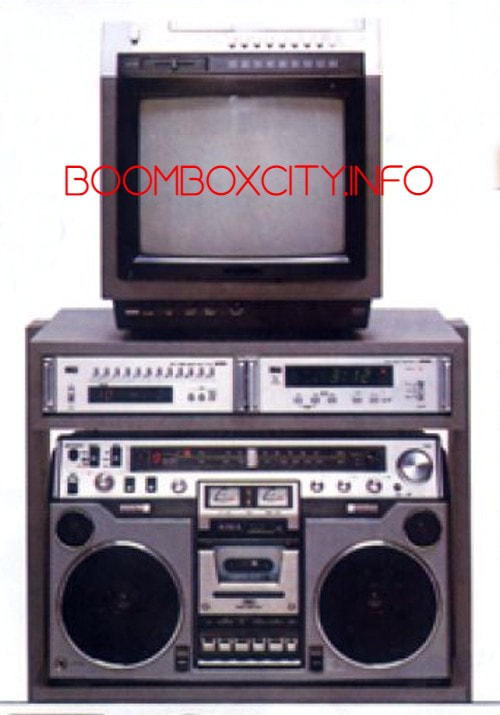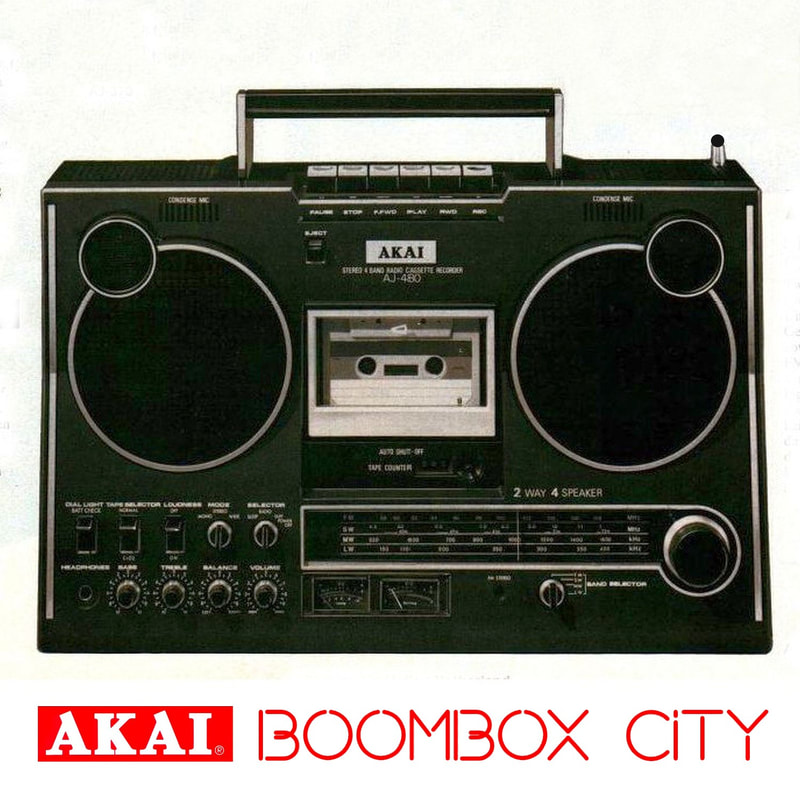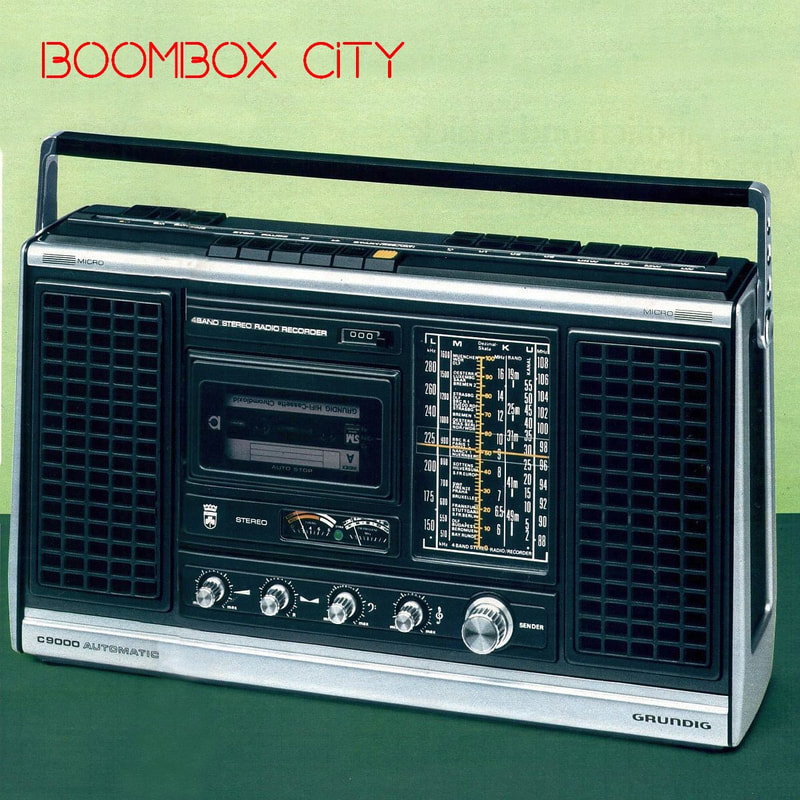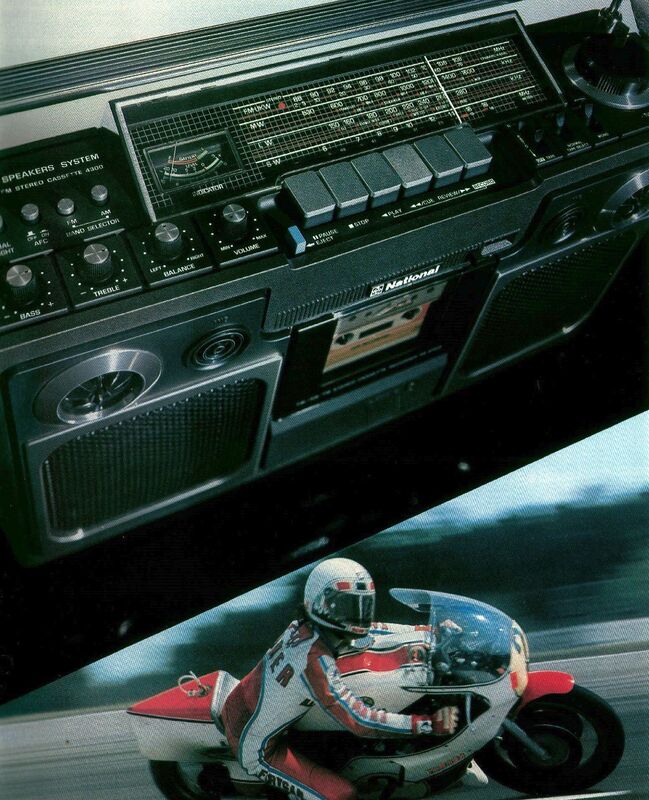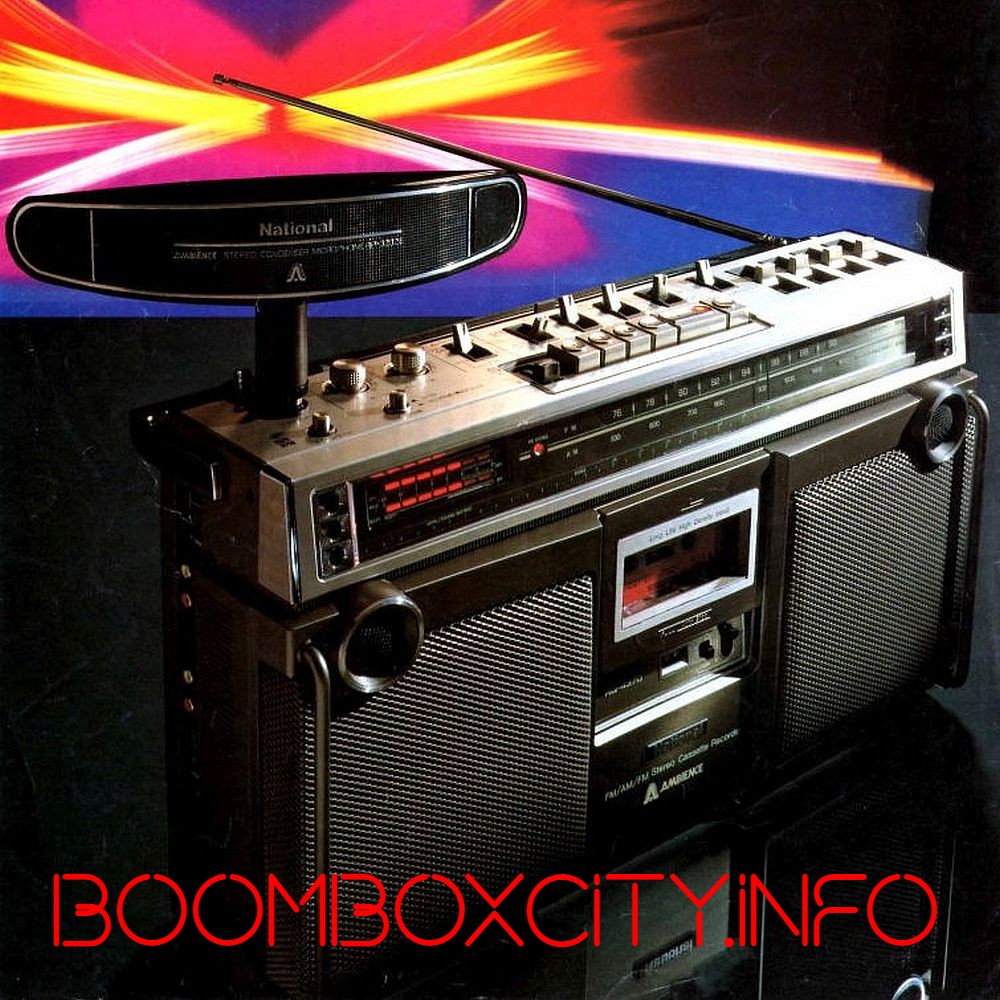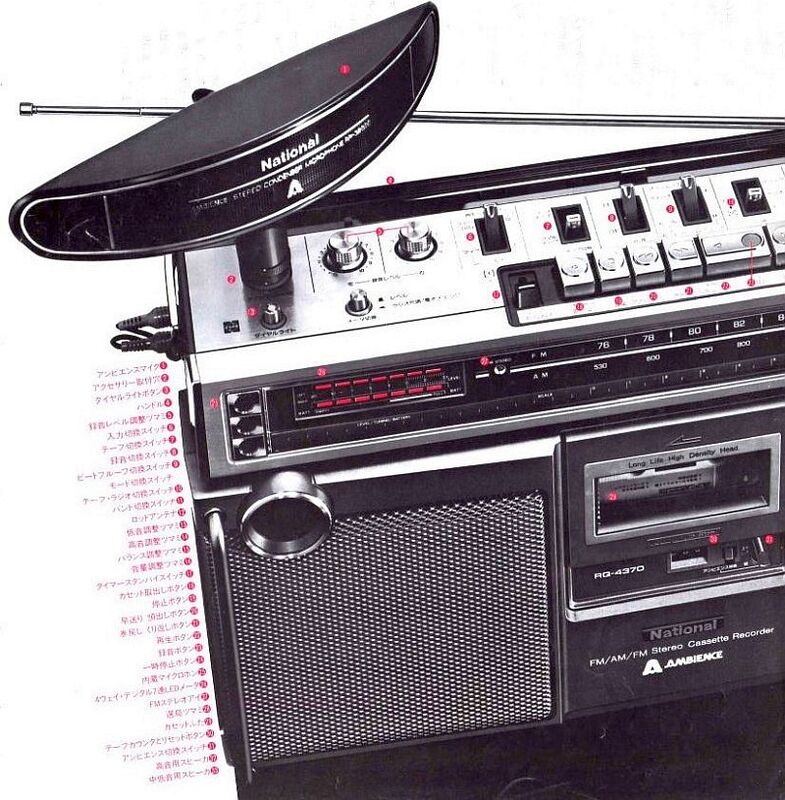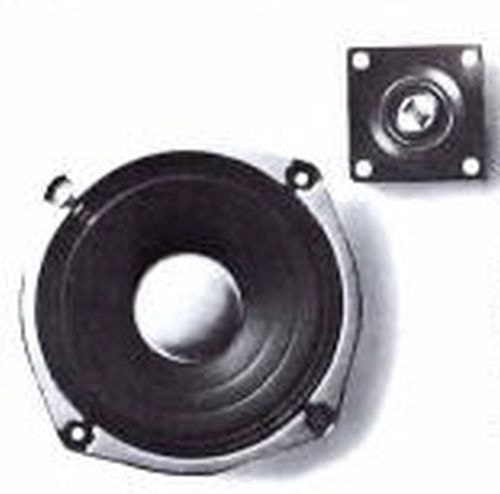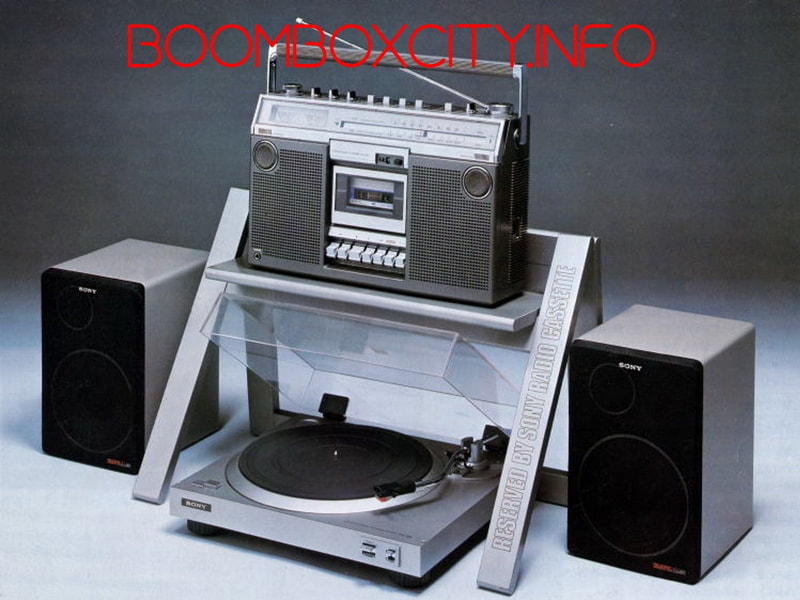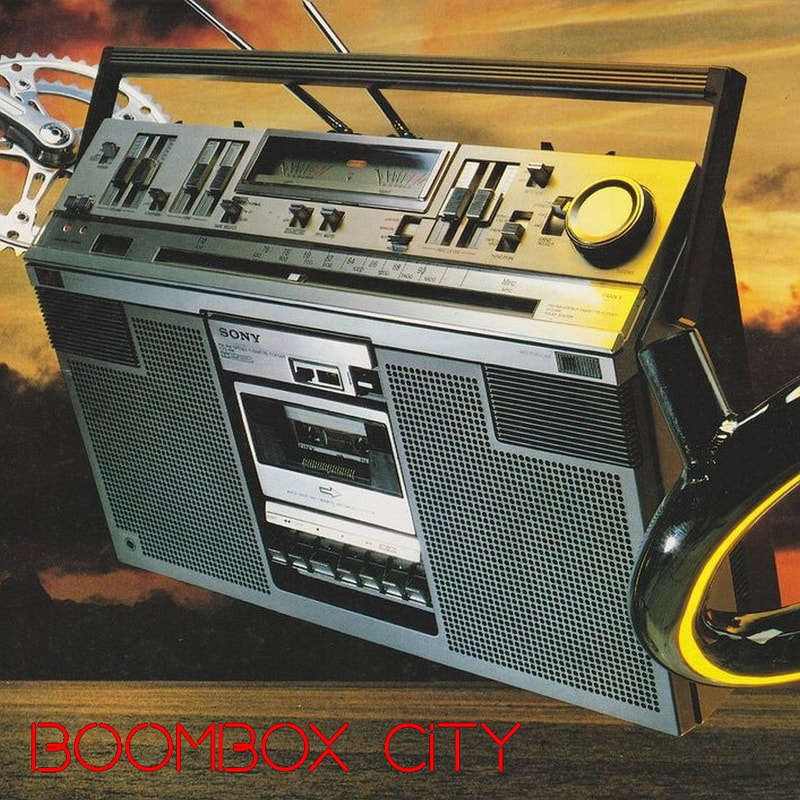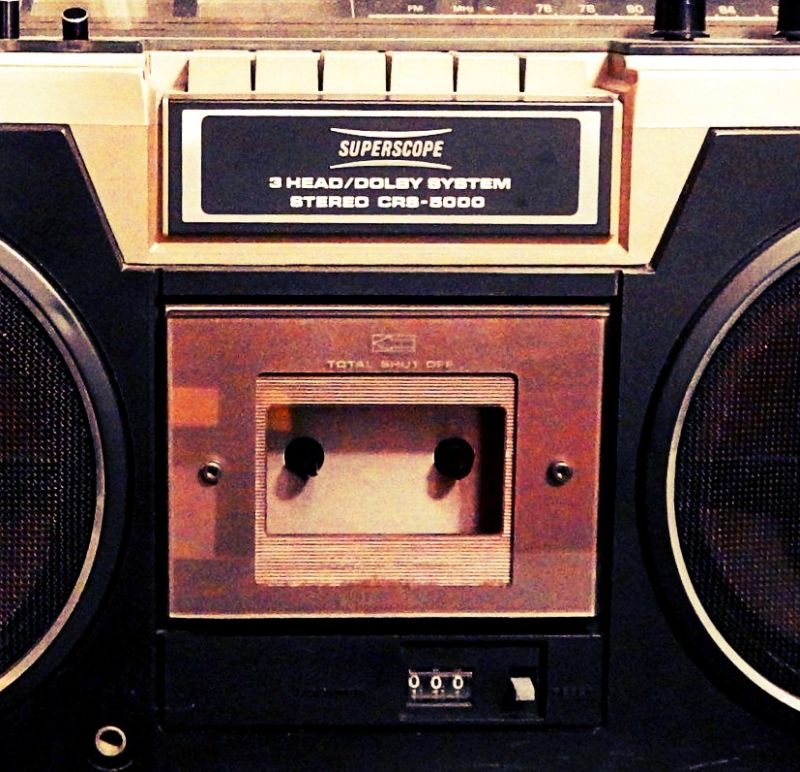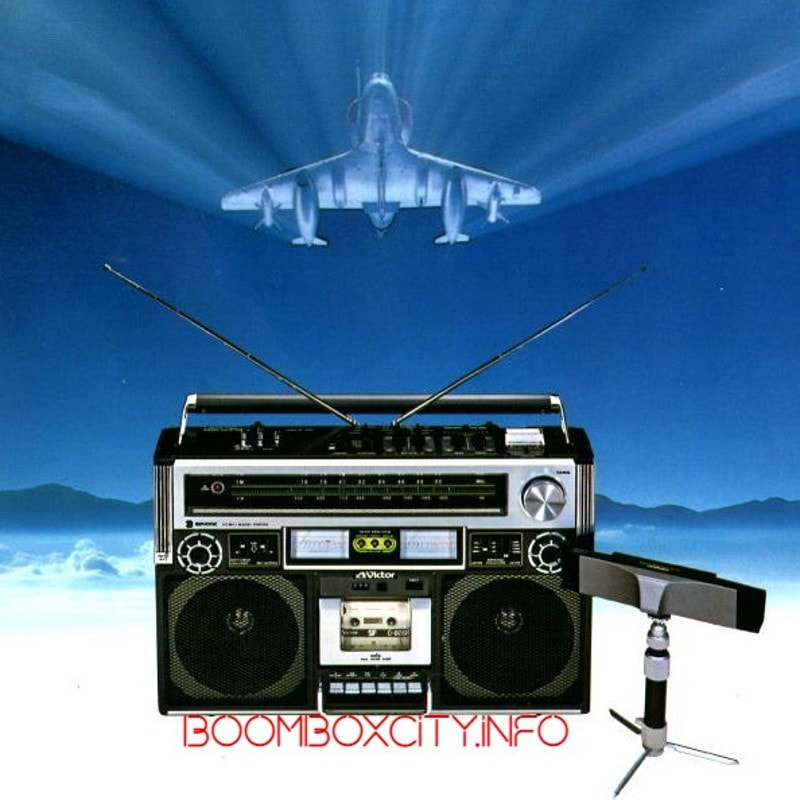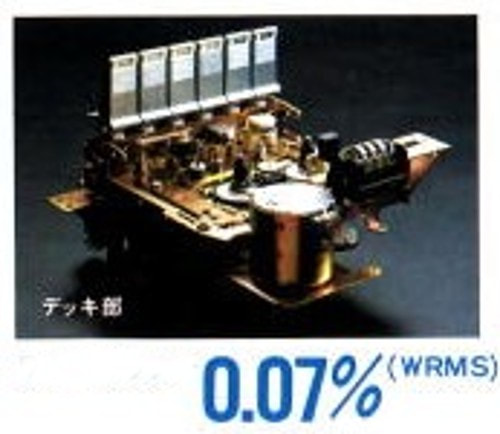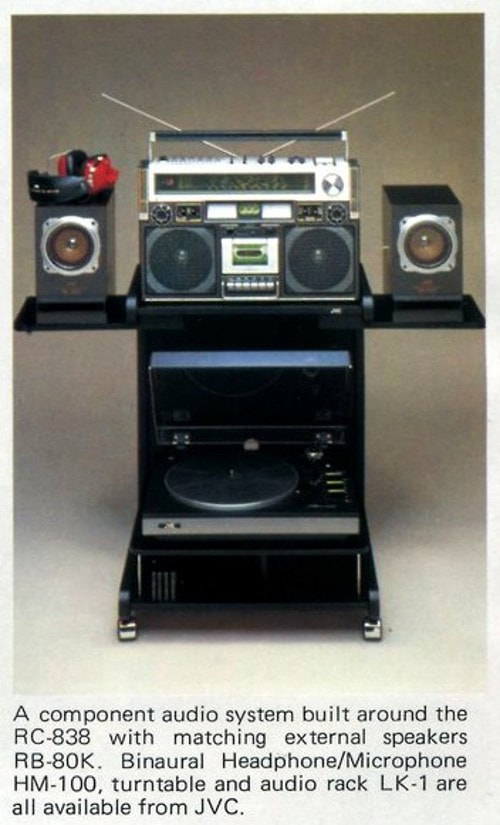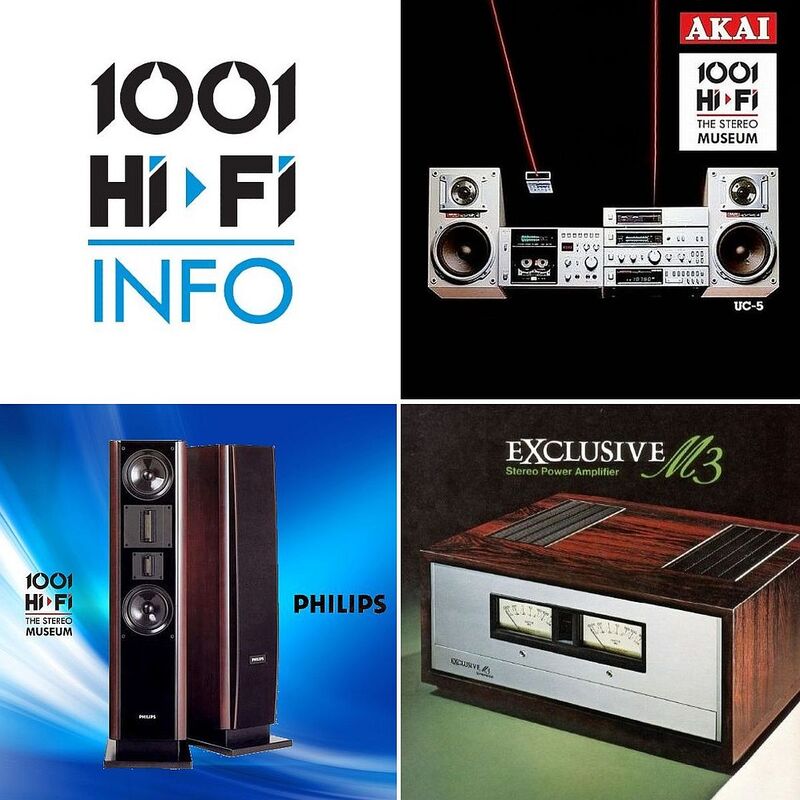AIWA TPR-920 (1977)
The AIWA TPR-920 was introduced in 1977. It features a 7.2 W (2 x 3.6W) IC amplifier that delivers the sound into two 12 cm full range loudspeakers. You can choose your favorite sound setting via separate bass and treble controls, loudness control and a 3 step Mono-Stereo-Wide Stereo switch. The TPR-920 also features dedicated Phono input and inbuilt stereo microphones. In order to further improve performance, the DM-511P external microphones and the SC-45 external loudspeakers were available as accessories just like a dedicated carrying case, the LC-920. The cassette section can handle normal and chrome tapes (with auto chrome tape selector) for a frequency response of 50-14000 Hz (chrome) and it uses an Ultra Hard Permalloy head. Recordings to a cassette can be made with the built-in ALC (automatic level control) or manually with separate L and R manual record level controls. Two multifunction level meters are used for L and R record level, battery level control and radio tuning level. Dimensions: 445x287x117 mm | Weight: 5.6 kg | Operation: Mains, External 9 V, 6xUM1 battery.
AIWA CS Series (1979)
The Aiwa CS Series was introduced in 1979. This series comprised the following models: CS80, CS70, CS60 and the smaller CS30. These were marketed as "portable Hi-Fi components" under the slogan, Basic Carry Compo. The top model of the series, the CS80, features a 7.4W (3.7W + 3.7W) (EIAJ/DC) amplifier powering a two-way loudspeaker system having a 16cm woofer and 52mm tweeter. The radio section is a two-band AM-FM Stereo analog tuner. The highlight of the CS80 model is the 9-track music search function of the cassette section. On the left side of the tuning scale is a digital indicator that shows the selected track. The cassette recorder is a one motor mechanism with FGH heads, mechanical "piano keys", manual recording level and two VU meters that can utilize normal and chrome tapes (40-12,500/14,000Hz Normal/Chrome). The CS70 and CS60 have smaller amplifier and speaker, the cassette recorder can handle only normal tape while the CS70 retains a more simplified music search system. Being promoted as a portable component with home hi-fi capabilities an almost endless array of add on components were available. These include among other the AA-16X battery operated amplifier, S-V22 TV multiplex tuner, AP-D22 and AP-D11 turntable, MT-22 timer, MIX-22 microphone mixer, SC-61, SC-E11 and SC-47 external loudspeakers, DM-511P microphones with mounting bracket. These components can be installed on racks such as the RK-24 or RK-23 but there are a few more unnamed models shown in the brochure. The "backpack carry system" shown in the main photo is also a factory accessory.
AKAI AJ-480 (1978)
AKAI Portables. For the Greatest Sound under the Sun. The AJ-480 from 1978 features a 2-Way 4-Speaker system with 12cm bass-mid and 5cm tweeter driven by a 2x2,5 watt amplifier (5,000mW of powerful stereo beauty). The amplifier section has bass, treble, balance, loudness and mono-stereo-wide control to shape the sound according to your preference. The cassette recorder is a simple stereo model that can handle normal and chrome tapes while recordings can be made from radio or the built-in condenser microphones. External loudspeakers or headphones can also be used with the AJ-480.
GRUNDIG C9000 (1978)
The Grundig C9000 from 1978 was the first STEREO portable radio-cassette recorder from this famous German manufacturer. The amplifier section featuring 2 IC power modules is specified 7W/ch Music power (if operated from mains) and 2W/ch Sinus (battery operated). The radio section has SW, LW, AM and FM Stereo but there are also 6 FM presets with small tuning knobs at the back of the unit. The cassette recorder section features a DC motor mechanism with electronic speed control, Long Life head with a frequency range of 90-12500 Hz, automatic record level control with VAT (variable fade in-out) function. The unit was available in black and later in silver color too. Dimensions: 460x260x110 mm | Weight: 5.8 kg | Operation: Mains, 12V ext., 6 batteries.
HITACHI PERDISCO TRK-8080 (1977)
Main features of the TRK-8080: FM Stereo, AM radio - 2-way loudspeaker system with 16cm woofer and 4cm tweeter - 4W + 4W EIAJ/DC power amplifier with separate bass, treble and Loudness control - AFC circuit for FM section - Mono, Stereo and Stereo WIDE selector - Mechanical control cassette recorder with soft eject door - Automatic record level - Normal and Chrome tape compatible (50-12.000Hz) - CUE and REVIEW tape search system - Built-in microphone and twin antenna - Connector for external microphone, external tape player, external loudspeakers and headphones. Radio wave bands, cassette recorder and connectors have market dependent features. The EU model has FM/AM/LW and SW radio and the Japanese market cassette recorder has manual recording level setting. With the help of a series of external add-on components your TRK-8080 could be easily turned into the heart of your home entertainment system. These components are the LA-88 System Rack with extensible arms to accommodate the APS-88 loudspeakers. The HT-320 was the recommended turntable, HD-80 the headphone, BIM-88 was an external wide-angle microphone while the LT0501 Spot Light provided the illumination for the turntable. Dimensions: 489x272x131 mm | Weight: 7 kg | Operation: Mains, battery.
National Panasonic RS-4300 (1978)
The RS-4300 was introduced in 1978 by Matsushita Electric Industrial Co., Ltd. under the National Panasonic brand name. Main features of this early Stereo unit are: FM Stereo, AM, LW, SW radio | Stereo-mono switch | FM Stereo indicator | 4 Speaker system featuring a 12cm woofer and a 3 cm tweeter per channel | Amplifier power rating 2x3,5W | Cassette recorder with Super-Permalloy-Head | Frequency range: Normal/Chrome 50-12,000/14,000 Hz | built-in condenser microphones | Separate bass and treble control | Dimensions: 408x224x109 mm | Weight: 5.3kg | Operation: Mains, battery (6 D cell)
National RQ-4370 (1978)
The National RQ-4370 was introduced by Matsushita Corporation in 1978. The main focus of this portable unit is the Ambience Sound: "A completely different experience in sound that begins where ordinary stereo ends. Ambience surrounds you with rich, full-dimensional sound that seems to come from everywhere. Not just from a left speaker and a right speaker, but from all around you". This Ambience sound however is not just limited to reproduction but also recording. For this purpose, the RP-3282E Ambience Stereo Condenser Microphone could be purchased as an accessory that can be mounted in a special socket that allows the rotation of this microphone. The cassette recorder section is a classic one motor mechanically controlled recorder that can handle Normal and Chrome tapes. (50-10.000 Hz Normal | 50-13.000 Hz Chrome). A multifunction Level/Tuning/Battery twin LED display is situated on the left side of the tuning scale. Power output is 6.6W delivered to a two-way loudspeaker system consisting of a 16cm woofer and 3cm tweeter.
PHILIPS AR-774 (1978)
The AR774 was the First (Compact, One Box) Stereo portable unit from Philips and it was introduced in 1978. Its tall silhouette is the result of the use of oval loudspeakers that are powered by a 2x4,5 W amplifier (Music power). A future Philips trademark, the adjustable Mono-Stereo-Spatial Stereo circuit is already featured on this model. The idea behind the Spatial Stereo is the fact that portable units have the speaker very close to each other so by widening the sound field one can achieve a better Stereo reproduction. The radio section feature FM Stereo, AM, LW and SW wavelengths. The cassette recorder is a basic model with electronically controlled motor, Long-Life head, Normal/Chrome tape compatible and it features automatic record level control. External turntable, tape-recorded, microphone and headphones can be used with the AR774. Dimensions:440x290x120 mm | Operation: Mains, battery (6 D cell).
SHARP GF-505 (1979)
The Sharp GF-505 was introduced to the Japanese market in 1979. A year later, with some slight modification (no speed and echo control on the front panel and added LW and SW radio section), the GF-9494 was introduced to the worldwide market. The GF-505 was available in two colors, black (GF-505SB) and silver (GF-505ST). Main features of the GF-505: FM Stereo, AM radio - 2-way loudspeaker system with 18cm woofer and 5cm tweeter - 2x6 W (EAIJ/DC-15V, 4ohm), separate bass, treble and loudness control. The cassette section features mechanically controlled cassette recorder with manual record level setting and VU level meters. It can handle Normal and Chrome tape with a frequency range of 50-12,000 Hz (Normal) and 50-15,000 Hz (Chrome) and wow and flutter figure of 0.09% (WRMS). The most interesting feature of the cassette player is the APSS (Automatic Program Search System) you can use to locate up to the 7th track on a cassette in both directions. (This system was called APLD - Auto Program Locate Device on the GF-9494). The GF-505 features a series of inputs and outputs for various add on components like the MC-55CL Stereo microphone, CP-303 external loudspeakers, RP-1010 turntable, AC power and car adapter, external roof aerial and also the MC-50CL wireless FM microphone. Dimensions: 556x136x310 mm | Weight: 8.9 kg | Operation: Mains, battery (10 D cell), car adapter.
SONY CFS-656 HotDog (1978)
The CFS-656 model was introduced by Sony in 1978. Whether they sold like HotDog or not I don't know but it is how they were advertised in Japan, the HotDog series. The CFS-656 features a front-loading cassette recorder (50-10,000/13,000 Hz Normal/FeCr tape) with mechanical keys and manual record level adjustment and needle type VU meters on the left front of the unit, right next to the AM-FM Stereo tuning scale. All the controls are situated on the top part where there is provision for an external microphone with mixing and echo function. The amplifier section is specified at 3.2W + 3.2W (EIAJ/DC) that are delivered to a two-way speaker system consisting of a 12cm woofer and a 3.3cm tweeter. On the side of the unit, we can find a pair of Line out jacks and a Phono line-in. As usual with Japanese market models a long series of accessories were available to transform your portable recorder into a home audio system. We will only mention a few such as the foldable SU-20 rack, PS-180 turntable, AN-66 FM antenna, SS-91 two-way loudspeakers, ECM-210M microphone set, DR-S3 headphones, DCC-130 car cigarette light adapter. Dimensions: 425x281x124mm | Weight: 5.5kg | Operation: Mains, 8 D size battery, car adapter.
SONY CFS-686 (1978)
The Sony CFS-686 was introduced in 1978 and it was part of a series known in Japan as "Stereo XYZ". The amplifier section has a 3.2W/ch (EIAJ/DC) power amplifier that is delivered to a loudspeaker system consisting of a 16 cm bass-mid and 4 cm tweeter per channel. The radio section has FM-Stereo and AM with manual tuning system. The cassette recorder section has a mechanically controlled drive system capable of handling Normal and Chrome/FeCr tapes (50-13000Hz). Recordings can be made with or without the use of the Dolby noise reduction circuit while recording level can be independently adjusted for left and right channels. Recording levels can be followed on a beautifully styled wide needle type VU meter section. Dimensions: 505x325x130 mm | Weight: 7.8 kg | Operation: Mains, 12V external, 8xD cells. A series of accessories were available such as external microphones, turntable, headphones, external speakers and more.
SONY CF-6600 (CF-590S) (1978)
The CF-6600 was part of the ZILBA'P series models introduced by Sony to the Japanese market in 1978. The international version of this model was the CF-590S. Promotional materials promised true stereo fidelity enhanced by wood cabinetry that gives the 4-speaker system (16-cm woofer, 5-cm tweeter) the same quality as free-standing speakers. There's also ample power (7.2 watts) and all the elaborate electronic extras that makes this Sony the most elaborate portable stereo of 1978. The Japanese market model (CF-6600) features AM-FM Stereo radio section while the international model (CF-590S) features a four-band radio, FM/MW/SW1/SW2. The cassette recorder is a one motor construction with hydraulic eject and compatibility for Normal and Fe-Cr tapes.
SUPERSCOPE by marantz CRS-5000 (1978)
The CRS-5000 uses a 3-head system with independent heads for playback and recording. This is the only 3-Head boombox known to exist. It also features Dolby noise reduction for hiss-free recordings, making clearer recordings possible. The power rating of the unit is rated at 5W+5W (EIAJ/DC). Other main features include: 2-way 4-speaker with 16cm woofer/4cm tweeter | Built-in timer standby mechanism that allows you to easily record your answering machine and standby recording by connecting a timer | Clear illuminated tuning dial | High-precision mechanism with wow/flutter 0.09% (WRMS) | Built-in loudness control | 3-position tape selector | Frequency characteristics Normal tape 40-14,000Hz Chrome tape 40-15,000Hz | External dimensions Width 48 x Height 248 x Depth 150 (mm) | Weight 8.5kg (including battery) | Input terminal External microphone (mini jack) x 2/Line input 2/Phono input | Output terminal external speaker (mini jack) | Power supply: mains, ext. DC 12V, 8 D batteries. Produced in Japan.
TOSHIBA ACTAS RT-8700S | BomBeat XI (1979)
The Toshiba Actas RT-8700S from 1979 (and the updated RT-8710S) are the international market versions of the Japan market BomBeat XI. This boombox is a single unit with four functions. With three different speaker mounting modes and a no-speaker mode for portable recording, the RT-8700S is super-flexible. If you want a compact radio cassette recorder, mount the speakers on top of the unit. If you want to use it as a table-top model, swing the speakers down on both sides of the radio cassette unit. For a component system the speakers can be separated from the center unit and placed wherever they suit you best. With the speakers removed, the handle can be fitted to the radio cassette unit so it can be used to make live outdoor recordings. Each of the quality speaker units has a 12cm woofer to produce rich lows and clear mid-range sound and a 5cm tweeter giving crisp, sharp highs. For convenience of operation, the controls are on the front panel arranged in functional groups. Other features included are: Stereo/Mono mode switch, Mike-mixing, Automatic-Level control, 3-way meter (Level/Battery/Tuning), Mechanical auto-stop, cue/review facility, sleep mechanism, external FM antenna terminals, stereo line-in/line-out jacks, external speaker terminals, jack for stereo headphones. Dimensions: 420x270x150 mm | Weight: 6.4 kg | Operation: Mains, 8 D size battery, car battery.
Victor (JVC) RC-727 (1977)
Hi-Fi Cassette Deck performance in a portable. There's a new angle to stereo enjoyment in the portable RC-727. Victor (JVC) designers have placed the four big speakers on carefully-calculated angles to widen the stereo perspective. The speakers include two bass-rich 12cm woofers and two 5cm tweeters for natural highs. Another bonus for better performance is the JVC-designed recording aid in the cassette section. It's the 5-LED Peak Level Indicator, letting you know at a glance as you record whether your recording levels are too low, too high or just right. The left and the right channel speaker systems use the finest high-power units. Each is a 2-way system, meaning that it contains both a woofer and a tweeter. The units themselves have light, firm cones, sturdy voice coils and powerful magnetic drive circuits. Total power in stereo is a big, clean 4 watts with negligible noise and distortion. The cassette recorder section lets you use popular ferric type cassettes or the more expensive chrome types and get best results each has to offer. The Stereo Wide control offers enhanced stereo presence results from the use of this circuit which boosts the midrange while decreasing distortion in the lows and highs. The RC-727 features independent bass and treble tone controls for tailored hi-fi sound, ALC (Automatic Level Control) for easy recording and manual recording level control for more elaborate recording techniques and two big meters for 3-way indication - broadcast signal strength, recording level and battery check. Dimensions: 446 x 260 x 124mm | Weight: 5.1 kg | Operation: Mains, 8xD cell, car.
Victor Biphonic 838 (JVC RC-838) (1978)
The 838 Biphonic model was introduced in 1978, first in Japan as Victor Biphonic-838 and worldwide as the JVC RC-838. One of its main features is the Biphonic processor, invented by JVC. This is a special processor that creates three-dimensional depth, spaciousness and pinpoint imaging from binaural recording but it also gives wide stereo effect to ordinary stereo recordings. The amplifier section is a 4W + 4W (EAIJ/DC) IC module that powers a 2-way speaker system consisting of a 16cm woofer and 5cm tweeter. The amplifier has bass and treble sliding controls, automatic loudness control and the RC-838 can also be used with external loudspeakers. The radio section has a tuning system with flywheel for smooth operation, quadrature type FM detection circuitry and PLL IC employed in the FM multiplex circuit to eliminate interchannel crosstalk. The radio has six-band section for FM/MW/SW1/SW2/SW3/SW4 (FM/AM for the Japanese market model). The cassette recorder section has a very low wow and flutter figure of only 0.07% (WRMS), it features Cronios (later Metaperm) head, automatic and manual recording level control with VU meters, separate bias and EQ selector for Normal/Chrome (later models with Metal tape capability). On the side panel there are sockets for external microphone, headphone, loudspeakers and line in/out. Various accessories were available that include the LK-1 audio rack (Bilbo 838), RB-80K or RB-90 external loudspeakers, JL-A15Q turntable. There were also special accessories such as the HM-200E Binaural headphone-mikes, MB-100 Binaural microphone, and special microphone holders that would clip where also a shoulder strap can be used. In popular culture the RC-838 was seen with rap artist LL Cool J. while the tweeter cover seems to resemble the front of a Star Wars Tie Fighter. Dimensions: 50.8x31.6x15.9 cm | Weight: 8.1kg | Operation: Mains, 8 D-cells.














